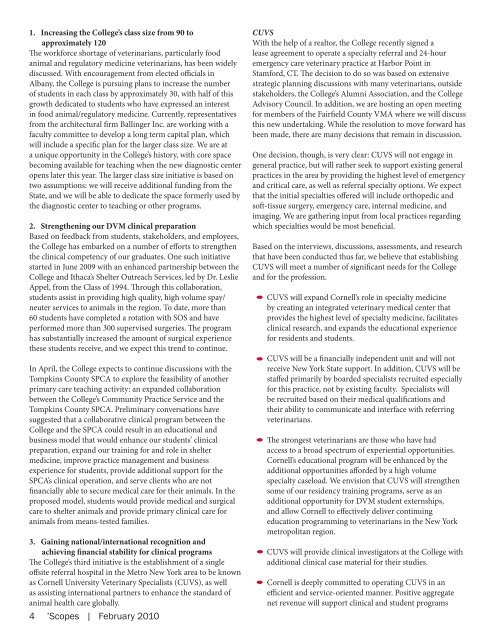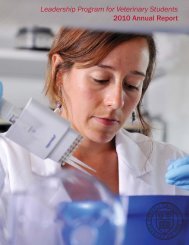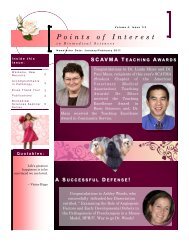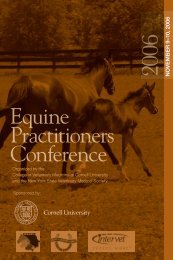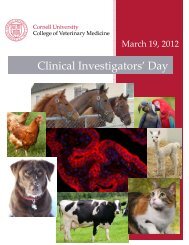From Classrooms to Clinics: - The College of Veterinary Medicine at ...
From Classrooms to Clinics: - The College of Veterinary Medicine at ...
From Classrooms to Clinics: - The College of Veterinary Medicine at ...
You also want an ePaper? Increase the reach of your titles
YUMPU automatically turns print PDFs into web optimized ePapers that Google loves.
1. Increasing the <strong>College</strong>’s class size from 90 <strong>to</strong><br />
approxim<strong>at</strong>ely 120<br />
Th e workforce shortage <strong>of</strong> veterinarians, particularly food<br />
animal and regula<strong>to</strong>ry medicine veterinarians, has been widely<br />
discussed. With encouragement from elected <strong>of</strong>fi cials in<br />
Albany, the <strong>College</strong> is pursuing plans <strong>to</strong> increase the number<br />
<strong>of</strong> students in each class by approxim<strong>at</strong>ely 30, with half <strong>of</strong> this<br />
growth dedic<strong>at</strong>ed <strong>to</strong> students who have expressed an interest<br />
in food animal/regula<strong>to</strong>ry medicine. Currently, represent<strong>at</strong>ives<br />
from the architectural fi rm Ballinger Inc. are working with a<br />
faculty committee <strong>to</strong> develop a long term capital plan, which<br />
will include a specifi c plan for the larger class size. We are <strong>at</strong><br />
a unique opportunity in the <strong>College</strong>’s his<strong>to</strong>ry, with core space<br />
becoming available for teaching when the new diagnostic center<br />
opens l<strong>at</strong>er this year. Th e larger class size initi<strong>at</strong>ive is based on<br />
two assumptions: we will receive additional funding from the<br />
St<strong>at</strong>e, and we will be able <strong>to</strong> dedic<strong>at</strong>e the space formerly used by<br />
the diagnostic center <strong>to</strong> teaching or other programs.<br />
2. Strengthening our DVM clinical prepar<strong>at</strong>ion<br />
Based on feedback from students, stakeholders, and employees,<br />
the <strong>College</strong> has embarked on a number <strong>of</strong> eff orts <strong>to</strong> strengthen<br />
the clinical competency <strong>of</strong> our gradu<strong>at</strong>es. One such initi<strong>at</strong>ive<br />
started in June 2009 with an enhanced partnership between the<br />
<strong>College</strong> and Ithaca’s Shelter Outreach Services, led by Dr. Leslie<br />
Appel, from the Class <strong>of</strong> 1994. Th rough this collabor<strong>at</strong>ion,<br />
students assist in providing high quality, high volume spay/<br />
neuter services <strong>to</strong> animals in the region. To d<strong>at</strong>e, more than<br />
60 students have completed a rot<strong>at</strong>ion with SOS and have<br />
performed more than 300 supervised surgeries. Th e program<br />
has substantially increased the amount <strong>of</strong> surgical experience<br />
these students receive, and we expect this trend <strong>to</strong> continue.<br />
In April, the <strong>College</strong> expects <strong>to</strong> continue discussions with the<br />
Tompkins County SPCA <strong>to</strong> explore the feasibility <strong>of</strong> another<br />
primary care teaching activity: an expanded collabor<strong>at</strong>ion<br />
between the <strong>College</strong>’s Community Practice Service and the<br />
Tompkins County SPCA. Preliminary convers<strong>at</strong>ions have<br />
suggested th<strong>at</strong> a collabor<strong>at</strong>ive clinical program between the<br />
<strong>College</strong> and the SPCA could result in an educ<strong>at</strong>ional and<br />
business model th<strong>at</strong> would enhance our students’ clinical<br />
prepar<strong>at</strong>ion, expand our training for and role in shelter<br />
medicine, improve practice management and business<br />
experience for students, provide additional support for the<br />
SPCA’s clinical oper<strong>at</strong>ion, and serve clients who are not<br />
fi nancially able <strong>to</strong> secure medical care for their animals. In the<br />
proposed model, students would provide medical and surgical<br />
care <strong>to</strong> shelter animals and provide primary clinical care for<br />
animals from means-tested families.<br />
3. Gaining n<strong>at</strong>ional/intern<strong>at</strong>ional recognition and<br />
achieving fi nancial stability for clinical programs<br />
Th e <strong>College</strong>’s third initi<strong>at</strong>ive is the establishment <strong>of</strong> a single<br />
<strong>of</strong>f site referral hospital in the Metro New York area <strong>to</strong> be known<br />
as Cornell University <strong>Veterinary</strong> Specialists (CUVS), as well<br />
as assisting intern<strong>at</strong>ional partners <strong>to</strong> enhance the standard <strong>of</strong><br />
animal health care globally.<br />
4 ’Scopes | February 2010<br />
CUVS<br />
With the help <strong>of</strong> a real<strong>to</strong>r, the <strong>College</strong> recently signed a<br />
lease agreement <strong>to</strong> oper<strong>at</strong>e a specialty referral and 24-hour<br />
emergency care veterinary practice <strong>at</strong> Harbor Point in<br />
Stamford, CT. Th e decision <strong>to</strong> do so was based on extensive<br />
str<strong>at</strong>egic planning discussions with many veterinarians, outside<br />
stakeholders, the <strong>College</strong>’s Alumni Associ<strong>at</strong>ion, and the <strong>College</strong><br />
Advisory Council. In addition, we are hosting an open meeting<br />
for members <strong>of</strong> the Fairfi eld County VMA where we will discuss<br />
this new undertaking. While the resolution <strong>to</strong> move forward has<br />
been made, there are many decisions th<strong>at</strong> remain in discussion.<br />
One decision, though, is very clear: CUVS will not engage in<br />
general practice, but will r<strong>at</strong>her seek <strong>to</strong> support existing general<br />
practices in the area by providing the highest level <strong>of</strong> emergency<br />
and critical care, as well as referral specialty options. We expect<br />
th<strong>at</strong> the initial specialties <strong>of</strong>f ered will include orthopedic and<br />
s<strong>of</strong>t -tissue surgery, emergency care, internal medicine, and<br />
imaging. We are g<strong>at</strong>hering input from local practices regarding<br />
which specialties would be most benefi cial.<br />
Based on the interviews, discussions, assessments, and research<br />
th<strong>at</strong> have been conducted thus far, we believe th<strong>at</strong> establishing<br />
CUVS will meet a number <strong>of</strong> signifi cant needs for the <strong>College</strong><br />
and for the pr<strong>of</strong>ession.<br />
CUVS will expand Cornell’s role in specialty medicine<br />
by cre<strong>at</strong>ing an integr<strong>at</strong>ed veterinary medical center th<strong>at</strong><br />
provides the highest level <strong>of</strong> specialty medicine, facilit<strong>at</strong>es<br />
clinical research, and expands the educ<strong>at</strong>ional experience<br />
for residents and students.<br />
CUVS will be a fi nancially independent unit and will not<br />
receive New York St<strong>at</strong>e support. In addition, CUVS will be<br />
staff ed primarily by boarded specialists recruited especially<br />
for this practice, not by existing faculty. Specialists will<br />
be recruited based on their medical qualifi c<strong>at</strong>ions and<br />
their ability <strong>to</strong> communic<strong>at</strong>e and interface with referring<br />
veterinarians.<br />
Th e strongest veterinarians are those who have had<br />
access <strong>to</strong> a broad spectrum <strong>of</strong> experiential opportunities.<br />
Cornell’s educ<strong>at</strong>ional program will be enhanced by the<br />
additional opportunities aff orded by a high volume<br />
specialty caseload. We envision th<strong>at</strong> CUVS will strengthen<br />
some <strong>of</strong> our residency training programs, serve as an<br />
additional opportunity for DVM student externships,<br />
and allow Cornell <strong>to</strong> eff ectively deliver continuing<br />
educ<strong>at</strong>ion programming <strong>to</strong> veterinarians in the New York<br />
metropolitan region.<br />
CUVS will provide clinical investiga<strong>to</strong>rs <strong>at</strong> the <strong>College</strong> with<br />
additional clinical case m<strong>at</strong>erial for their studies.<br />
Cornell is deeply committed <strong>to</strong> oper<strong>at</strong>ing CUVS in an<br />
effi cient and service-oriented manner. Positive aggreg<strong>at</strong>e<br />
net revenue will support clinical and student programs


